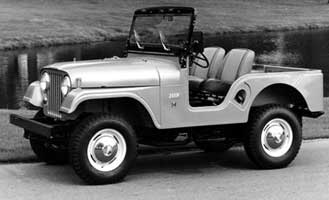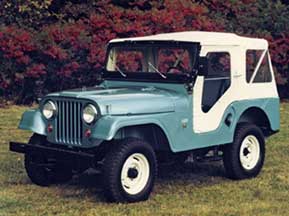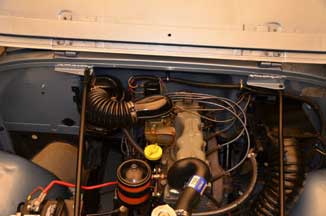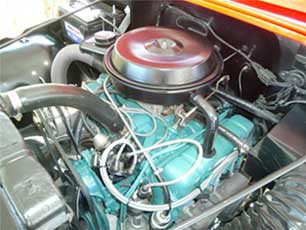CJ5 1955 to 1975
History - (1955-1971) Willys CJ-5 "Universal"
CJ-5 Production Total: 603,303


CJ-5 Illustration
In 1955, under new leadership by Kaiser Industries, Willys Motors began to promote their newest member of the CJ series, the CJ-5, a model that marked a significant departure from the “flat-fender” CJs, with its rounded front fender design and squeezed grille (to accommodate larger headlights). Influenced by the Korean War M38A1 Jeep, the CJ-5 included updates such as rounded fenders, a hood and body made of heavy gauge sheet metal, a larger windshield frame, increased length on the riding springs, form fitting front adjustable bucket seats, a deeper, back-lit instrument panel, rear seating options for 4 passengers, and a new passenger car type handbrake located to the left of the driver underneath the instrument panel.
In 1965, the CJ-5 and CJ-6 four-cylinder Willys Hurricane Engine was supplemented with 155 hp (116kW), as a result of Kaiser having purchased the casting rights to the Buick 225 cu in (3.7 L) V6 Dauntless.
While the CJ-5 remained fairly consistent throughout many years of production, 1972 brought with it several changes worth mentioning. In 1970, Kaiser ownership was replaced by a new company, American Motors (AMC). It was decided in 1971, that the GM engine would be retired, replaced in the following year (1972) with engines made by American Motors, the one-barrel 248 ci in (4.2L) and the AMC 304 cj in (5L) V8 engine. In order to make room for the new engines, the fenders and hood were stretched 5 inches (127 mm) and the wheelbase was stretched 3 inches (75 mm). Updates to the drive train at that time included the front axle becoming a full-floating Dana 30.
1976 brought several new changes - the tub, frame and windshield frame were modified. As a result, tops from years 1955-75 will not fit a 1976-83 CJ-5 and vice-versa. In 1979, the standard engine became the 258 cu in (4.2 L) which now featured a two-barrel carburetor.Starting in 1980 and on through the close of production in 1983, the CJ-5 came factory with a "Hurricane"-branded version of the GM Iron Duke I4.
The Tuxedo Park: Trim package, CJ-5, or CJ-6?
In 1961, Kaiser was coming to the realization that it had an image problem. The broader masses believed the Jeep to be a great…vehicle — that is, if you needed to work on the farm, go hunting, or partake in some other industrious activity. To fix this “problem” they decided to introduce a new, more “upscale” version of the CJ-5. Accordingly, in 1961, the Tuxedo Park was introduced as a trim package. It is widely believed that these trim packages (Tuxedo Park I, II and III) were offered between 1961-1963, and included chrome add-ons, along with an “Indian Ceramic” steering wheel (in place of the standard black). The seats also received an upgrade to “Black British Calf Grain Vinyl with Indian Ceramic Facings” (Trim Code L-29).
In 1964, Kaiser promoted the Tuxedo Park as it’s own separate model (Tuxedo Park Mark IV) for the CJ-5A and CJ-6A. The Tuxedo Park Mark IV included several options that set it apart from the standard Jeep®. These options included:
- Chrome front bumper
- Chrome hood badges
- Windshield clamp catch
- Chrome drop down license plate holder
- Chrome tail lamps
- Hubcap displaying the “Jeep” emblem
- Column shift
**If you suspect you may have one of these models, check the prefix of your vehicle’s VIN tag. The CJ-5A Tuxedo Park Mark IV has a prefix of “8322″, while the CJ-6A Tuxedo Park Mark IV has a prefix of “8422″.
Unfortunately, this model never gained the popularity that was hoped for, and only approximately 460 of the CJ-6A models were ever produced, making them a rare find for those in the market. If you have a Tuxedo Park Mark IV, it is much more likely that yours is one of the CJ-5A models. While these vehicles did not capture the undivided attention of the masses, they were a valid attempt at becoming something “more” than what Jeep® appeared to be in 1960, and opened the door for other models that were to come…
CJ-5 Specs:
Special CJ-5 Models:
1961-1963 Tuxedo Park Mark III
1965 "Tuxedo Park Mark IV"
1969 Camper
1969 462
1970 Renegade I
1971 Renegade II
1972-1983 Renegade Models
1973 Super Jeep
1977-1983 Golden Eagle
1979 Silver Anniversary
4-134 F Head Motor (473 or 475)
Years Offered: 1955-1971 CJ-5
Engine Type: L4-134 “Go-Devil”
Number of Cylinders: 4
Cubic-In. Displacement: 134.22 CID (2199.53 cc)
Horsepower: 60 hp (45 kW) @ 4000 rpm
Torque: 105 ft-lbf (142 N-m) @2000 rpm
Compression Ratio: 6:48:1
Valvetrain: L-head

(Gross): 3750 lb. (1701,0 kg.)
(Shipping): 2163 lb. (981,1 kg.)
(Curb): 2274 lb. (1031,5 kg.)
Length (overall): 135 9/16” (3,44 m.)
Width (overall): 71 3/4” (128 cm.)
Height (overall): 67” (170 cm.)
Ground Clearance: 8” (20,3 cm.)
Tread (front and rear): 48 7/16” (123 cm.)
Fuel Capacity: 10 1/2 Gal.
Transmission: T-90
Transfer Case: Dana 18
Front Axle: Dana 25 (1952-60) or Dana 27 (1961-1971)
Rear Axle:Dana 44
Wheelbase: 81” (206 cm.)
Other: 1 Piece Windshield, Fenders curve down
CJ5 Engines: (cont'd)
V5-225 Dauntless Motor(473)
Years Offered: 1966-1971 CJ-5
Engine Type: Buick 225 V6 Engine
Number of Cylinders: 6
Bore x Stroke: 3.75” x 3.40”
Cubic-In. Displacement: 225 (3.68 L)
Horsepower (net): 160@4200
Torque (net): 235@2400
Compression Ratio: 9:0:1
Valve Configuration: OHV

